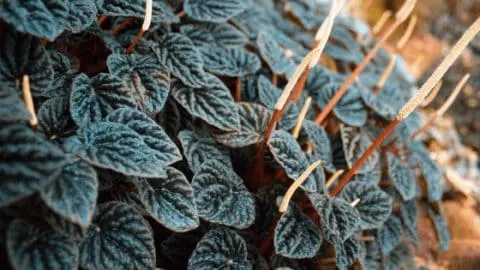Peperomia caperata has grown to become one of the most popular varieties of Peperomia in home gardens.
The reason is obvious if you look at the plant – it’s a tiny little stunner.
The leaves are small and heart-shaped with a heavily corrugated texture because of being deep veined.
It is referred to as a “quilted texture”.
The color of the leaves can be anywhere from deep bottle green to a bronze tinged to dark reddish-brown.
The plant is a perennial mound-forming type that looks adorable to grow in small pots for your tabletops.
Peperomia caperata Care
To care for Peperomia caperata use well-draining soil using peat, compost, mulch or humus, bark, and pumice or perlite and a temperature between 65-75°F (18-24°C). Keep humidity at 40 – 50% and put the Peperomia in bright indirect light in an east-facing window when growing indoors. Water once the top 2” of soil is dry (5cm). Use a diluted chemical fertilizer at 1/3 strength once a month in spring and summer.
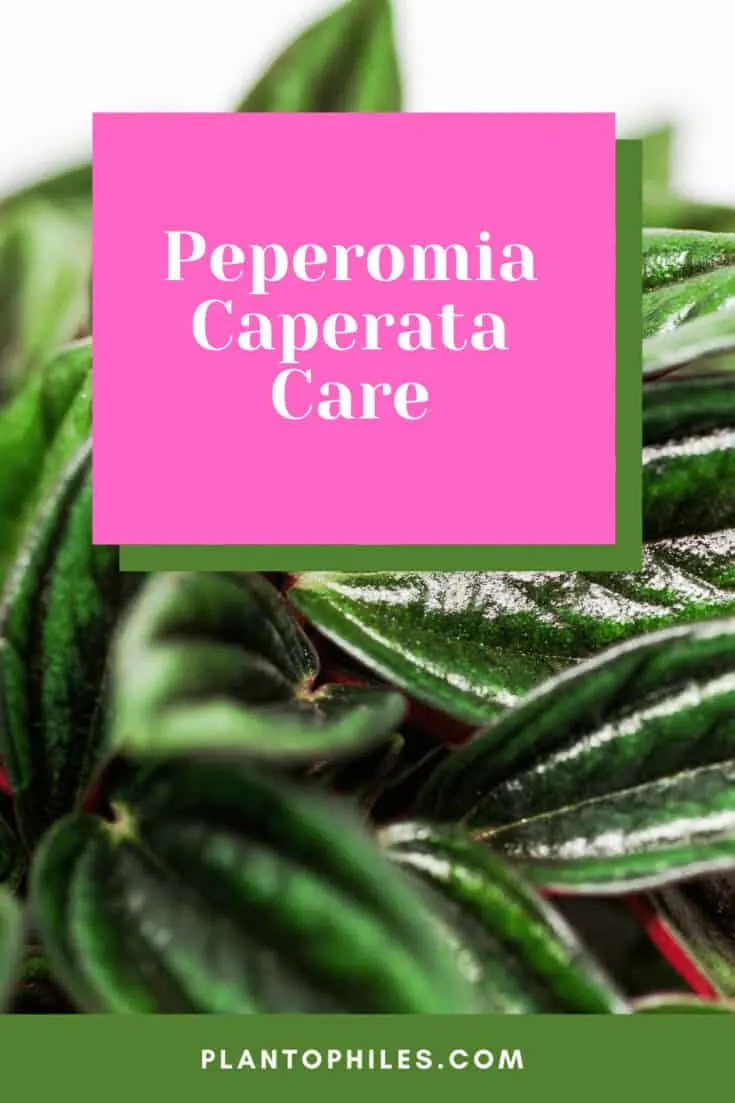
Peperomia caperata Care
During summers the whole mound gets covered in white erect spiky flowers.
Even though the flowers in themselves are nothing to write home about, the whole appearance of these spikes sticking out of the mound of textured leaves is the main attraction behind growing Peperomia caperata.
Because of the show stopping character of this plant, even one pot is enough to pull the whole room together.
But the deal with Peperomias is that nonone ever stops with one variety!
So, follow this Peperomia caperata care guide carefully and once you’re successful growing it, you should move on to other species in this wonderful genus.
Table of Contents
Peperomia caperata PLANT CARE GUIDE
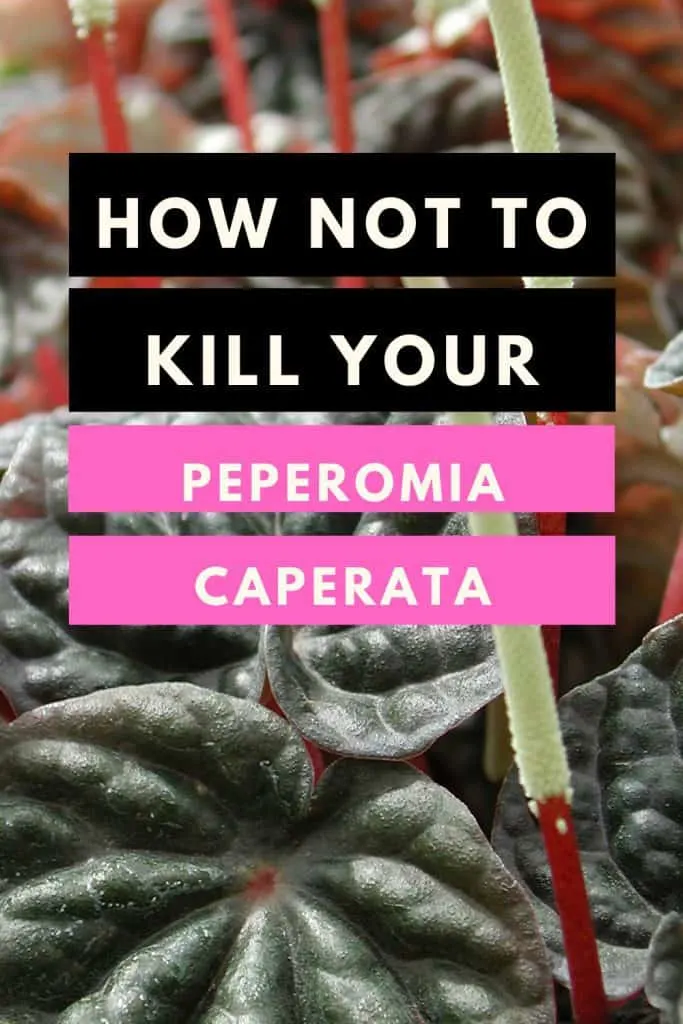
Peperomia caperata Care
SOIL
Grow Peperomia caperata in a porous well-draining potting mix using peat, compost, mulch or humus, bark, and pumice or perlite.
Peperomia caperata care is governed by its epiphytic nature.
This species is native to Brazilian forests where they are found growing in the cracks of trees drawing nutrients from the air, rain, water, or debris accumulating around its roots.
You need to grow Peperomia caperata in a well-draining soil mix dense in organic nutrients.
This is to ensure that the roots breathe and excess water leaves the pot very quickly without accumulating at the bottom. Finally, the organic matter retains moisture whilst keeping the roots warm and humid.
We grow Peperomia caperata for its compact size. Naturally, it needs very little soil substrate per plant.
A combination of peat, compost, mulch or humus, bark, and some drainage material such as pumice or perlite makes for a great mix.
Make sure all your ingredients are sterile. A smart Peperomia caperata quick hack is to get a high-quality succulent mix from the store and add perlite for extra chunkiness.
Try to grow Peperomia caperata in slightly acidic soil with a pH ranging from 6.0 to 6.6. Adding a lot of organic content improves soil acidity.
Pro tip: throw in a single layer of pebbles or gravel or kiln-fired brick bits in the bottom of the pot.
This is great for drainage and also allows for easy damage-free transfer during repotting.
LIGHT
Peperomia caperata care requires bright indirect or filtered light and must be protected from direct rays.
They love bright light but wilt in direct rays, especially in summer. My own experience with them has been that they take well to morning sun, so I’ve given them an east window spot in my kitchen along with other peperomias.
You can use 40% shade cloth if your garden is open.
If you grow Peperomia caperata under a bigger plant or huddled in the midst of other plants, that sort of arrangement works great to filter the rays.
Peperomia caperata care is made easy by the fact that the plant tries to communicate with you.
Watch your plant closely for signs like dull pale leaves, which means too low light, and sudden drooping or burned leaves, which indicates direct sun.
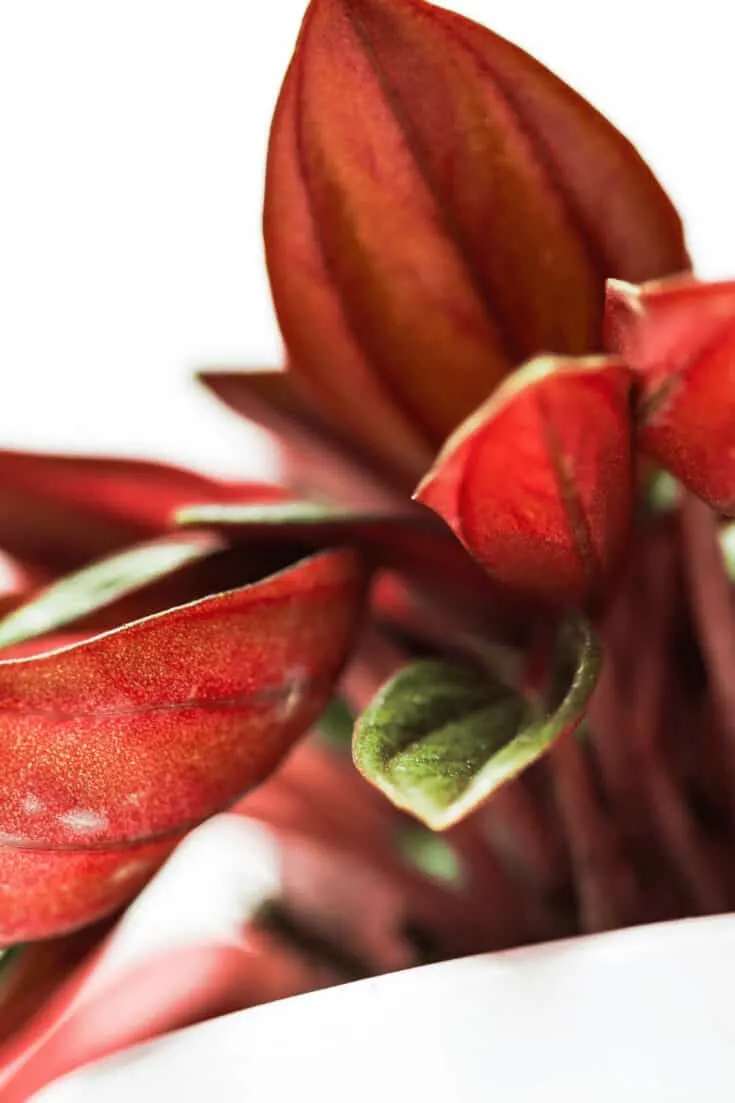
Peperomia Caperata needs bright indirect light
WATERING
Water a Peperomia caperata horoughly once the top 2” of soil is dry (5cm).
A lot of internet material advises that peperomias like moisture.
This is a misleading statement because peperomia varieties differ widely in their care requirements.
For proper Peperomia caperata care, first, get the soil conditions right.
Once you’ve nailed the well-draining porous texture of the soil, make sure there’s less of the soil mix altogether.
The right watering level for Peperomia caperata care is to maintain the soil at barely moist.
Water deeply and dry out the soil partially between waterings using the topsoil dryness test before watering again.
This is the best way to avoid root rot caused by overwatering and/or poor drainage.
During the cold and dry winter, months use warm water and cut back on the frequency.
Peperomia caperata care tip: Don’t get the leaves wet.
If you do, they may all get brown spots and die. Water from the sides instead.
What I’ve provided you are general guidelines.
Ultimately, what your plant needs depends on the weather (temperature, humidity, time of the year) where you live.
The rule of thumb is whatever you do for succulents should normally work for Peperomias.
TEMPERATURE
Peperomia caperata prefers temperatures ranging from 65-75°F (18-24°C).
If you live close to the equator you can grow Peperomia caperata outdoors throughout the year.
Otherwise, it’s best to grow it in a pot and bring it indoors in the colder months away from the cold drafts.
Peperomia caperata care can get tricky in cold weather countries. Although it is said to be a temperature tolerant tropical plant,
I’ve not had success with it when temperatures go below 55ºF (13ºC). The fleshy plant dies at the slightest sign of frost.
One Peperomia caperata care point is to keep it away from drafts of air-conditioners and heaters.
They stress easily under extreme temperature fluctuations.
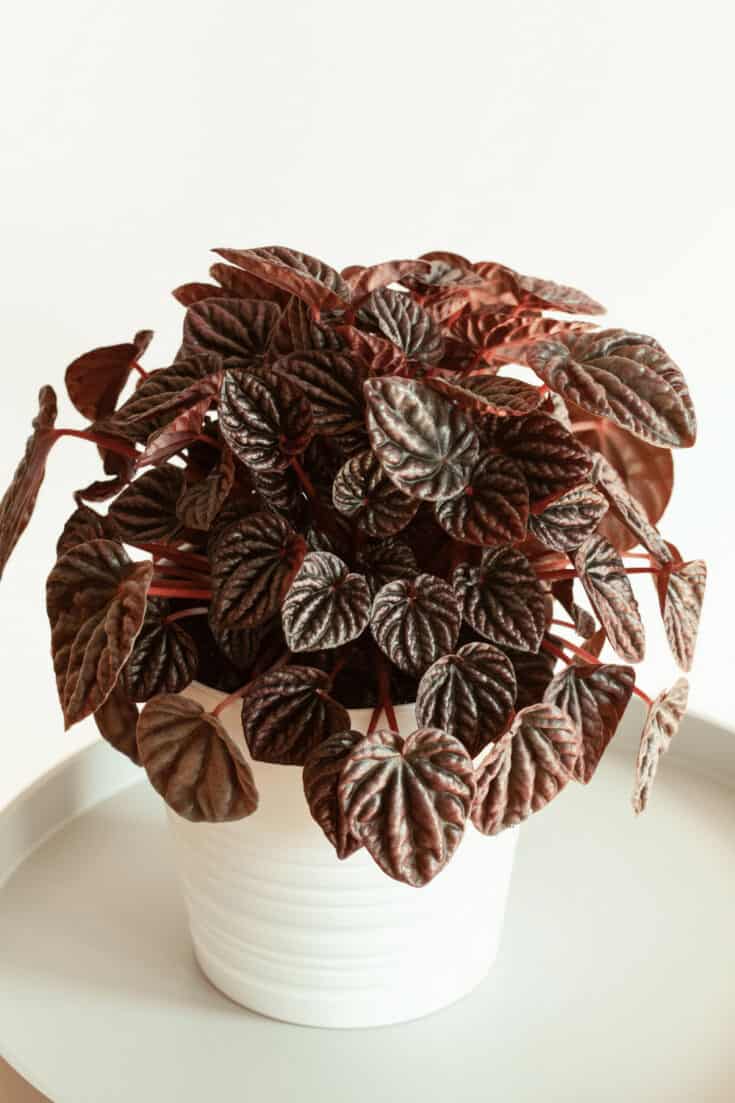
Peperomia caperata grows best at a temperature between 65-75°F (18-24°C)
HUMIDITY
Peperomia caperata needs humidity between 40-50%.
While it is indeed humid in the native habitat, humidity isn’t a critical aspect of Peperomia caperata care.
You may need to do some active management in the winter months but that’s about it.
Humidity needs to be maintained at reasonable levels. An average humidity level of 40 – 50% is all you need to grow Peperomia caperata.
Give the leaves an occasional bath in the summer months. Just make sure you do it on a watering day and only in the mornings for proper Peperomia caperata care.
For indoors, you don’t need a humidifier unless it’s desert dry in your growing room.
The plants take well to occasional misting with soft water, especially during dry weather.
You can grow Peperomia caperata in an open terrarium within which a humid environment is naturally created.

Peperomia Caperata is fine with average humidity between 40-50%
FERTILIZER
For Peperomia caperata use e a balanced succulent fertilizer once a month during spring and summer.
The ideal Peperomia caperata care hack it to stick to an organic feeding routine.
I ensure this while potting the plant including rich organic manure in the soil mix and to replenish the topsoil in the growing months.
If you have been using chemicals in your garden, you could go for a triple diluted solution than what’s prescribed.
So, for example, if the Rx ratio is 5ml per gallon of water, make it 5ml per 3 gallons of water. Use a liquid chemical that’s easy to dilute.
My Peperomia caperata care schedule includes a balanced succulent fertilizer once a month during growing months and I stop feeding the plant in winter months.
PROPAGATION
Peperomia caperata can be easily propagated from leaf cuttings, stem tip cuttings, and plant division.
The most interesting part of Peperomia caperata care is propagation.
Almost every part of the plant propagates readily. I’ve seen that accidentally broken leaves or stems if left undisturbed in the soil readily take root.
I’ve explained propagation in detail in a later section.
GROWTH
You can grow Peperomia caperata to about 8 inches (20 cm) tall after.
This is achieved under the best Peperomia caperata care conditions in a stress-free environment.
By right conditions I mean warm and moist equatorial weather. In the colder zones growth will be slower.
This plant is an evergreen perennial with a mound-forming growth habit.
Because of this, it gets a compact globular appearance as it grows.
Peperomia caperata care needs no pruning, just routine removal of dying leaves will do. Propagate abundantly during growing months.
The flowers of the Peperomia caperata are spiky white and green of about 2-3” (5 to 8 cms )in length.
When the whole plant is covered in spikes in the flowering season it does look interesting.
POTTING
Peperomia caperata doesn’t mind a root-bound potting condition as with epiphytic succulents.
So you should use a tiny pot and not let the roots swim around in a large pot. Small terracotta pots are a very good choice.
But don’t mistake this to mean tightly packed soil – it’s quite the opposite.
The root systems of these plants are relatively small, so in relation to their size they don’t need large pots.
The roots bind themselves well to the soil mix. The stems are delicate and tend to break while repotting.
I prefer not to repot this plant. Instead, I propagate abundantly.
If the plant seems to be dull and flagging in its current pot then I repot with additional manure in the soil mix.
Peperomia caperata PROPAGATION STEP-BY-STEP GUIDE
Propagate Peperomia caperata from leaf cuttings
- Wait until June, just ahead of the growing season in the tropics.
- Cut a few healthy leaves along with the petiole from a bug-free mother plant.
- Let the cuts callous out for a day.
- Pop the leaves 4 inches apart in a germination tray with a 50/50 peat/perlite soil mix.
- The stalk should be firmly under the soil. Press down the leaf in the soil just a bit.
- Insert hairpins through the leaf into the soil so that the leaf veins are firmly in contact with the soil. Flat, like coasters on a table.
- Place the tray in 70°-75°F (21 – 24°C) under a growlight, misting the soil occasionally.
- The soil moisture should be maintained but shouldn’t be wet because your leaf will definitely rot away.
- New plants will start growing from the leaf base in four to eight weeks.
Propagate Peperomia caperata from stem cuttings
Some people don’t have much success with leaf cuttings.
For them, I’d recommend the stem cutting method which is fairly straightforward and fail-proof for most home growers.
- Use a mother plant that is fairly mature and has been flowering regularly.
- Check the base of basal branches and choose a branch that is thick and healthy
- Cut about three to inches of stem tip with several leaves on it and set it aside to callous for a day.
- You either stick this in water or evenly moist soil (50/50 peat + perlite)
- Place this in warm partial shade and make sure the water stays at room temperature under ALL circumstances.
- The stem should take root in around 4 to 8 weeks.
Propagate Peperomia caperata from plantlets
The plant throws tiny puppies around its base which you can separate after they are slightly big. I normally let these pups grow fairly big along with the mother plant. I separate them only when I am repotting.
COMMON PROBLEMS WITH Peperomia caperata
Pest control
As the Peperomia caperata is a herbaceous plant with fleshy stalks, sap sucking bugs or pests could be an issue. We’re talking mealybugs, aphids, scales. Here are some precautions you should take.
- I constantly check the underside of leaves because that’s where the bugs start. If I spot even a single bug I pinch off the leaf immediately.
- I wash my plant on a watering day and make sure the leaves dry out. The plant should be kept where there’s good air circulation so that the leaf surface dries up.
- Include an organic insecticide like neem oil or insecticidal soap in your Peperomia caperata care routine as a best practice.
Some of the other common problems seen when you grow Peperomia caperata are listed below:
Fading dull leaves
If you grow Peperomia caperata for its deep green/red foliage this isn’t something you want to see.
It’s probably due to low light. So move the pot to a bright spot.
Leaves dropping off suddenly
There are a couple of reasons for this. Firstly, if your Peperomia caperata is exposed to cold draft the leaves will fall off.
You know what to do next.
Immediately bring the plant indoors.
Secondly, I would immediately check for a root rot indicated by the base of the plant being soggy and dislodged from the roots.
An important part of Peperomia caperata care is watering and soil.
If the plant is young there’s, unfortunately, little you can do to save it.
If it’s a mature plant with several branches, salvage healthy stems and repot them in a sterile airy mix.
Brown spots on the leaves
If the brown spots are spreading then it is a fungal infection arising due to excessive wetness on the leaves.
If you’ve been watering from the top and drenching the leaves you should stop that immediately and forever.
Remove affected leaves. Keep the plant in an airy ventilated spot.
Leaf edges burn
Either direct sun exposure or chemical salts in the water can burn up the leaves.
Using RO water helps not just peperomia but all delicate houseplants in general.
Old leaves discolor and the plant looks dull and slow-growing
The yellowing of leaves is a typical sign that the plant isn’t getting enough nutrients.
Give it a light-balanced fertilizer to improve the NPK levels for a few weeks.
Rainwater misting regularly is also helpful. If it’s a mature plant, you can repot it with a lot of good slow-release organic manure.
TIPS TO GROW Peperomia caperata PROBLEM-FREE
- Avoid overwatering your Peperomia caperata
- Never water from the top wetting the leaves.
- Peperomia caperata is rather shade loving. Bright shade is perfect for it.
- Fertilize only during the growing season and stick with organic soil additives
- Peperomia caperata likes it root bound.
- Grow Peperomia caperata in terracotta pots to allows roots to dry out
- Wash your Peperomia caperata plant once in a way to keep pests at bay
- Use natural insecticides like neem oil treatment as a preventive
- Propagate Peperomia caperata abundantly to cover for losses
FREQUENTLY ASKED QUESTIONS ABOUR Peperomia caperata
Is Peperomia caperata a succulent?
The plant has leaves that are slightly thick like succulents, but they are essentially epiphytes. Most of their needs are like succulents with the difference that they need more humidity than succulents. Certain other varieties of Peperomia however have even more succulent-like features, like Prayer Peperomia.
Can you grow Peperomia caperata under artificial light?
They can grow very well under fluorescent light kept on for about 12 hours a day.
Are peperomia plants poisonous?
Peperomia plants are safe for humans and animals. They do not bring any harm if ingested. However, it is best to keep them away from children and pets.
CONCLUSION
Peperomias are not considered easy maintenance and beginners often feel discouraged after one or two losses.
This Peperomia caperata care guide is meant to improve your growing experience so that you start enjoying the treasures of this genus for what they really are.
It’s a very exciting plant to have in your collection not only because of the stunning looks but also because of certain aspects like leaf propagation which is such fascinating science!
Once you’re successful in growing this variety you could move on to other Peperomias.
You should consider growing other popular variants like Variegated Peperomia (Peperomia obtusifolia), Peperomia metallica, Peperomia magnoliifolia.
Happy gardening!

Daniel has been a plant enthusiast for over 20 years. He owns hundreds of houseplants and prepares for the chili growing seasons yearly with great anticipation. His favorite plants are plant species in the Araceae family, such as Monstera, Philodendron, and Anthurium. He also loves gardening and is growing hot peppers, tomatoes, and many more vegetables.

